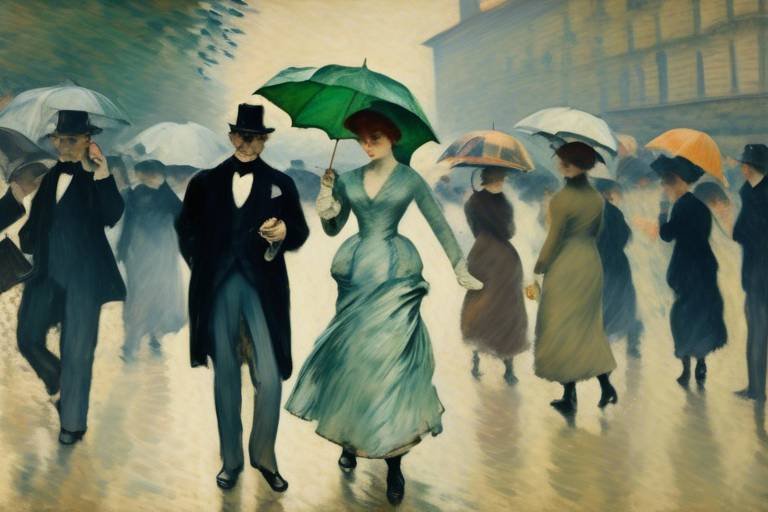Art in the Age of Enlightenment - A Cultural Shift
Art in the Age of Enlightenment marked a significant cultural shift that revolutionized the artistic landscape of the 18th century. During this era, a wave of intellectual and philosophical movements swept across Europe, challenging traditional beliefs and paving the way for a new era of artistic expression. The Enlightenment was a period characterized by a focus on reason, science, and individualism, shaping the artistic styles and themes of the time.
The Enlightenment Movement was a transformative period that emphasized the power of human reason and rationality in shaping society and culture. Artists during this time were inspired by the ideals of the Enlightenment, seeking to reflect the values of liberty, progress, and tolerance in their work. The movement encouraged a shift towards a more critical and analytical approach to art, breaking away from the constraints of tradition and superstition.
Neoclassicism emerged as a dominant artistic style during the Age of Enlightenment, drawing inspiration from classical antiquity and the rationalism of ancient Greece and Rome. Artists embraced a more structured and disciplined approach to art, emphasizing clarity, logic, and order in their compositions. Neoclassical works often depicted heroic figures, historical events, and moral themes, reflecting the intellectual ideals of the Enlightenment.
Rococo art, in contrast, embraced a more ornate and decorative style that celebrated sensibility, pleasure, and beauty. Artists of the Rococo period sought to evoke emotion and delight through their intricate and playful compositions. The movement reflected a shift towards a more lighthearted and indulgent approach to art, capturing the essence of luxury and refinement in the Age of Enlightenment.
Portraiture became a popular genre during the Enlightenment, with artists capturing the individuality and character of their subjects in exquisite detail. Portraits served as a reflection of the sitter's social status, accomplishments, and personal attributes, embodying the values and ideals of the Enlightenment. Artists used portraiture as a means of conveying the inner essence of their subjects, creating intimate and revealing portrayals that captured the spirit of the age.
The depiction of landscapes and nature's sublime beauty became a prominent theme in Enlightenment art, reflecting a growing appreciation for the natural world. Artists sought to capture the awe-inspiring grandeur of nature, portraying landscapes as symbols of divine creation and spiritual inspiration. The sublime landscapes of the Enlightenment evoked a sense of wonder and reverence for the power and majesty of the natural world.
Allegorical art played a significant role in conveying deeper meanings and moral messages during the Age of Enlightenment. Artists used symbols and allegories to communicate complex ideas and philosophical concepts, inviting viewers to contemplate the deeper significance of their work. Allegorical art served as a visual language through which artists could explore the complexities of human nature, morality, and the pursuit of knowledge.
Salons emerged as vibrant centers of artistic discourse and intellectual exchange during the Enlightenment, bringing together artists, philosophers, and patrons to engage in lively debates and discussions. These gatherings provided a platform for the exchange of ideas, fostering a spirit of creativity and innovation in the artistic community. Salons played a crucial role in shaping the cultural landscape of the Enlightenment, influencing artistic trends and movements of the time.
Artistic patronage flourished during the Age of Enlightenment, with patrons supporting artists who championed the values and ideals of the era. Wealthy benefactors commissioned works that promoted themes of liberty, reason, and progress, providing artists with the resources and encouragement to pursue their creative vision. Patronage played a vital role in sustaining artistic innovation and fostering a climate of artistic freedom and expression.
The legacy of Enlightenment art continues to resonate in the artistic landscape of today, influencing subsequent movements and cultural developments. The art of the Enlightenment era laid the foundation for modern artistic expression, shaping the way we perceive and appreciate art. Its enduring impact serves as a testament to the power of art to reflect and shape the values and ideals of society, transcending time and inspiring generations to come.

The Enlightenment Movement
The Age of Enlightenment, a period of intellectual and philosophical revolution in the 18th century, brought about a significant shift in the world of art. This era was characterized by a focus on reason, science, and individualism, shaping artistic styles and themes in profound ways.
The Enlightenment Movement was a transformative period that emphasized rationality, empirical evidence, and the power of human intellect. It marked a departure from the traditional beliefs of the past, encouraging critical thinking and the pursuit of knowledge. Artists during this time were inspired by these ideals, infusing their works with themes of reason, logic, and the celebration of individual freedoms.
One of the key aspects of the Enlightenment Movement was its rejection of superstition and blind faith, instead advocating for scientific inquiry and the application of reason to all aspects of life. This shift in thinking had a profound impact on the art world, leading to the emergence of new artistic styles and themes that reflected the changing intellectual landscape.
Enlightenment thinkers believed in the power of education and the importance of spreading knowledge to empower individuals. This emphasis on education and intellectual growth influenced artists to create works that not only entertained but also enlightened viewers, prompting them to question the world around them and explore new ideas.
Moreover, the Enlightenment Movement encouraged artists to break free from traditional constraints and express themselves more freely. Art became a platform for social commentary, political critique, and the exploration of human nature. This period saw the rise of artists who challenged the status quo, pushing boundaries and redefining the role of art in society.
Overall, the Enlightenment Movement was a time of intellectual awakening and cultural transformation that left a lasting impact on the world of art. It paved the way for new artistic movements and inspired generations of artists to explore the depths of human experience and knowledge.

Neoclassicism and Rationalism
The Age of Enlightenment marked a significant cultural shift in the 18th century, shaping the art world with its emphasis on reason, science, and individualism. This article delves into various aspects of art during this period, exploring how intellectual and philosophical movements influenced artistic expression.
Neoclassicism emerged as a dominant artistic style during the Age of Enlightenment, drawing inspiration from classical antiquity. Artists of this period sought to revive the ideals of ancient Greece and Rome, emphasizing order, symmetry, and rationality in their works. Rationalism played a crucial role in shaping Neoclassical art, with a focus on logic and intellect rather than emotion.

Rococo Art and Sensibility
The Age of Enlightenment marked a significant cultural shift in the 18th century, where intellectual and philosophical movements reshaped the artistic landscape. This article delves into the various aspects of art during this period, exploring how reason, science, and individualism influenced artistic expression and creativity.
During the Age of Enlightenment, Rococo art emerged as a prominent style characterized by its ornate and playful nature. This artistic movement reflected the pursuit of pleasure, love, and beauty in art, embodying a sense of lightness and elegance. Rococo artists embraced sensibility, focusing on emotions and personal experiences rather than strict adherence to classical ideals.

Portraiture and Enlightenment Ideals
During the Age of Enlightenment, portraiture emerged as a powerful medium to encapsulate the essence of individuals, reflecting not only their physical attributes but also their character, accomplishments, and status within society. Artists delved deep into the psyche of their subjects, aiming to capture the inner essence that defined them as unique beings.
Portraits became more than mere representations; they became windows into the soul, showcasing the values and ideals that individuals held dear. Whether it was a nobleman exuding authority and dignity or a commoner embodying humility and resilience, each portrait told a story of the subject's place in the world and their relationship to the evolving societal landscape.
Artists skillfully utilized light, shadow, and composition to convey not just the physical likeness of the sitter but also their inner qualities and beliefs. Through meticulous attention to detail, from the expression in the eyes to the posture of the body, portraits became mirrors reflecting the Enlightenment values of reason, individualism, and self-awareness.
Moreover, portraiture played a vital role in promoting the ideals of the Enlightenment by immortalizing individuals who championed liberty, tolerance, and progress. Patrons commissioned portraits not only to preserve their likeness for posterity but also to align themselves with the intellectual and philosophical currents of the time.
As a result, portraits became symbols of enlightenment ideals, serving as visual testaments to the values that defined an era marked by intellectual curiosity and societal transformation. Through the medium of portraiture, artists captured the essence of individuals in a way that transcended mere representation, embodying the spirit of an age defined by profound introspection and cultural evolution.

Landscapes and Nature's Sublime
The Age of Enlightenment marked a significant cultural shift in history, influencing various aspects of society including art. This period saw a surge in intellectual and philosophical movements that shaped artistic expressions, emphasizing reason, science, and individualism.
During the Age of Enlightenment, artists found inspiration in the natural world, depicting landscapes in a way that evoked a sense of awe and wonder. The sublime beauty of nature was captured on canvas, reflecting the grandeur and power of the natural environment.
Artists sought to convey the majesty of mountains, the serenity of lakes, and the vastness of forests, using their paintings to transport viewers to distant and untouched landscapes. Through intricate brushwork and careful attention to detail, they recreated nature's beauty with a sense of reverence and admiration.
Landscapes were not merely representations of physical locations but also served as metaphors for human emotions and spiritual experiences. The sublime in nature was seen as a reflection of the divine, prompting contemplation and introspection in the viewer.
Moreover, the depiction of landscapes during this period highlighted humanity's relationship with the natural world, emphasizing the interconnectedness between humans and their environment. Artists used the power of nature to convey a sense of harmony, balance, and the eternal cycle of life.
Q: How did the Enlightenment influence artistic expressions?
A: The Enlightenment promoted rationality, individualism, and the pursuit of knowledge, which influenced artists to create works that reflected these values. Art during this period often focused on reason, logic, and the exploration of human emotions and experiences.
Q: What role did salons play in the artistic discourse of the Enlightenment?
A: Salons served as intellectual hubs where artists, philosophers, and patrons gathered to discuss art, ideas, and social issues. These gatherings facilitated the exchange of knowledge and fostered creativity and innovation in the artistic community.
Q: How did Enlightenment ideals shape artistic patronage?
A: Patrons during the Enlightenment supported artists who promoted values such as liberty, tolerance, and progress. They commissioned works that reflected these ideals, contributing to the production of art that aimed to educate, inspire, and provoke thought.
Q: What is the legacy of Enlightenment art in modern times?
A: The impact of Enlightenment art can still be seen in contemporary artistic movements and cultural developments. The emphasis on reason, individualism, and the exploration of human experiences continues to influence artists and audiences today.

Allegorical Art and Symbolism
During the Age of Enlightenment, art took on a new dimension through allegorical representations and symbolism. Artists of this era used symbols and allegories to convey deeper meanings and moral messages in their works. These symbolic elements added layers of complexity and significance to the art of the time, inviting viewers to delve beyond the surface and contemplate the underlying messages.
Allegorical art often featured personifications of abstract concepts such as justice, wisdom, or love, represented through symbolic imagery. For example, a figure holding scales might symbolize justice, while a winged figure could represent freedom. These symbols were carefully chosen to communicate specific ideas and values, making the artworks rich with hidden meanings waiting to be deciphered.
Symbolism played a crucial role in conveying moral lessons and philosophical ideas in art during the Enlightenment. Through the use of symbols, artists could address complex societal issues, explore human emotions, and provoke contemplation among viewers. The allegorical nature of the art encouraged intellectual engagement and critical thinking, inviting the audience to interpret and analyze the artwork beyond its visual appeal.
Furthermore, allegorical art served as a vehicle for artists to express their views on political, social, and cultural matters in a subtle yet impactful manner. By incorporating symbols and allegories into their works, artists could communicate dissent, advocate for change, or celebrate virtues without overtly stating their intentions. This allowed for a nuanced approach to addressing sensitive topics and challenging the status quo through art.
In essence, allegorical art and symbolism in the Age of Enlightenment represented a fusion of artistic expression and intellectual discourse. Through the intricate use of symbols and allegories, artists created visually captivating works that transcended mere aesthetics, inviting viewers to engage with the deeper layers of meaning embedded within the art.

Salons and Artistic Discourse
During the Age of Enlightenment, salons emerged as vibrant centers of intellectual exchange and artistic discourse. These gatherings, hosted by influential figures like wealthy patrons or talented artists, provided a space for thinkers, writers, philosophers, and artists to come together and engage in lively discussions about various topics ranging from politics and philosophy to art and literature. It was in these salons that new ideas were born, debated, and disseminated, shaping the cultural landscape of the time.
The atmosphere in these salons was often characterized by a sense of intellectual curiosity and open-mindedness, where individuals from diverse backgrounds could exchange perspectives and challenge each other's beliefs. Artists found inspiration in these settings, drawing from the rich tapestry of ideas and opinions shared during these gatherings to fuel their creative endeavors. The salons not only fostered artistic innovation but also served as platforms for social critique and reflection on the prevailing norms and values of society.
One of the key features of salons was the democratization of knowledge and the promotion of free thought. Unlike traditional academic institutions that were often exclusive and hierarchical, salons welcomed individuals from different social classes and backgrounds, creating a melting pot of ideas and experiences. This inclusivity helped break down barriers and challenge established hierarchies, paving the way for a more egalitarian and progressive society.
Additionally, salons played a crucial role in shaping artistic trends and movements by providing a forum for artists to showcase their work, receive feedback, and engage in critical dialogue with their peers. The exchange of ideas in these intimate settings fostered a sense of camaraderie among artists and intellectuals, leading to collaborations and cross-pollination of creative practices. The impact of these salons reverberated beyond the artistic sphere, influencing broader cultural and political developments of the time.

Artistic Patronage and Enlightenment Values
During the Age of Enlightenment, artistic patronage played a crucial role in promoting and sustaining the values of this intellectual movement. Patrons were individuals, often wealthy and influential, who supported artists financially and provided them with the resources needed to create art that aligned with Enlightenment ideals. These patrons believed in the power of art to convey messages of liberty, tolerance, and progress, and they actively sought out artists who shared their vision.
Artistic patronage was not merely a financial transaction but a partnership based on shared values and goals. Patrons encouraged artists to explore themes of reason, humanism, and social reform in their work, shaping the direction of artistic expression during the Enlightenment. By supporting artists who championed these values, patrons played a significant role in shaping the cultural landscape of the time.
One notable aspect of artistic patronage during the Enlightenment was the emphasis on the artist as an independent thinker and creator. Unlike previous eras where artists were often seen as craftsmen or servants of the church or nobility, Enlightenment patrons valued artists as intellectuals and visionaries in their own right. This shift in perception elevated the status of artists and allowed them greater freedom to express their ideas and beliefs through their art.
Artistic patronage also extended beyond financial support to include intellectual and moral guidance. Patrons engaged in discussions with artists, providing feedback, inspiration, and encouragement to explore new ideas and techniques. The relationship between patron and artist was not just transactional but collaborative, fostering a sense of camaraderie and shared purpose in the pursuit of artistic excellence.
Through their patronage, individuals and institutions became key players in promoting Enlightenment values through art. By commissioning works that celebrated reason, individualism, and social progress, patrons helped disseminate these ideas to a wider audience and perpetuate the legacy of Enlightenment art for future generations to appreciate and learn from.

Legacy of Enlightenment Art
As we reflect on the Legacy of Enlightenment Art, it becomes evident that the impact of this period extends far beyond its time, shaping the course of artistic expression and cultural values for generations to come. The art of the Enlightenment era served as a catalyst for future movements, influencing the way artists approached their craft and the subjects they chose to depict.
One of the key legacies of Enlightenment art is its emphasis on reason, rationality, and the pursuit of knowledge. Artists during this period sought to depict the world in a more realistic and objective manner, moving away from the fantastical and idealized representations of previous eras. This commitment to truth and accuracy laid the foundation for the development of realism in art.
Furthermore, the Enlightenment's focus on individualism and the celebration of human potential left a lasting mark on artistic expression. Portraiture, in particular, flourished during this time as artists sought to capture the unique qualities and personalities of their subjects. These portraits not only served as visual records of individuals but also as reflections of the values and ideals of the Enlightenment.
The legacy of Enlightenment art can also be seen in the continued exploration of nature and the sublime in art. Artists were inspired by the beauty and power of the natural world, seeking to convey the awe and wonder it evoked. This appreciation for nature's grandeur laid the groundwork for the development of landscape painting as a distinct genre.
Moreover, the use of allegory and symbolism in art, a common practice during the Enlightenment, continues to influence artists to this day. By imbuing their works with deeper meanings and moral messages, artists were able to engage viewers on a more intellectual and emotional level, creating a rich tapestry of visual storytelling.
In conclusion, the Legacy of Enlightenment Art serves as a testament to the enduring impact of this transformative period in history. By embracing reason, individualism, and a deep appreciation for the natural world, artists of the Enlightenment laid the groundwork for future artistic movements and cultural developments, shaping the course of art history for centuries to come.
Frequently Asked Questions
- What was the significance of the Enlightenment movement on art?
The Enlightenment movement had a profound impact on art by promoting reason, science, and individualism. Artists began to focus on depicting reality and exploring new ideas, leading to a shift in artistic styles and themes.
- How did Neoclassicism differ from Rococo art?
Neoclassicism was inspired by classical antiquity and emphasized reason and logic, while Rococo art was characterized by ornate and playful styles that focused on pleasure and beauty. Neoclassical art aimed for simplicity and clarity, while Rococo embraced extravagance and sensibility.
- What role did allegorical art play during the Enlightenment?
Allegorical art used symbols and hidden meanings to convey moral messages and deeper truths. Artists employed allegories to communicate complex ideas and critique societal norms, making art a powerful medium for intellectual discourse and reflection.
- How did salons contribute to artistic development during the Enlightenment?
Salons served as intellectual hubs where artists, philosophers, and patrons gathered to discuss art, ideas, and social issues. These gatherings fostered creativity, debate, and collaboration, shaping the direction of artistic movements and cultural trends.
- What lasting impact did Enlightenment art have on future artistic movements?
Enlightenment art laid the foundation for future artistic movements by championing values such as liberty, tolerance, and progress. The emphasis on individual expression, rationality, and social critique in Enlightenment art influenced subsequent generations of artists and shaped the course of art history.



















